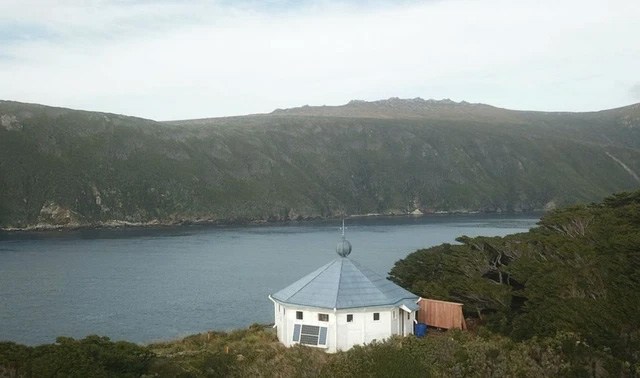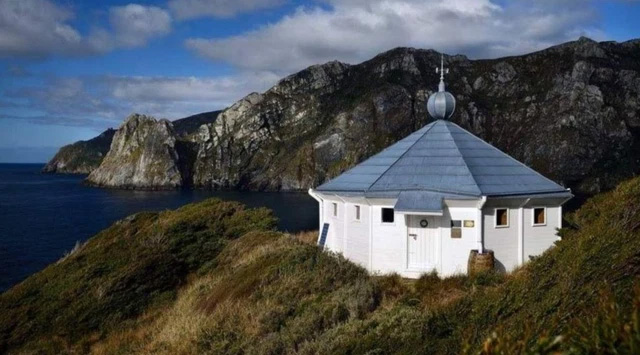Explore San Juan de Salvamento - the lighthouse at the end of the world
The lighthouse dates back to 1884 when the South Atlantic Expeditionary Division under Commodore Augusto Lasserre arrived. They built this place as a county with a prison and a lifeguard station on the island to help those unfortunate enough to be shipwrecked around Cape Horn. The lighthouse is built on a rock called Cape San Juan.
It is nicknamed "The Lighthouse at the End of the World".

This is the oldest lighthouse in Argentina.
Commodore Augusto Lasserre added "de Salvamento" (meaning "rescue") to the lighthouse's name to clarify its purpose. Since then the lighthouse has been named San Juan de Salvamento. It is the oldest lighthouse in Argentina and the first to be built in the southern waters.
The lighthouse was originally a 16-sided beech house, less than 5 meters high and about 9 meters in diameter. Light comes from eight fixed oil lamps placed behind several windows with Fresnel lenses.

The lighthouse was originally a 16-sided beech house, less than 5 meters high.
But the location of the lighthouse does not provide the best visibility and illuminance. Although it is 60 meters high, the light from the oil lamps is too weak and the fog often obscures the lighthouse. As a result, many ships continued to sink around New Year Island and many islets north of the lighthouse.
So in 1901, the Argentine government, in collaboration with the International Organizing Committee for Antarctic Exploration, decided to erect the New Year lighthouse a little further north on Observatory Island. The New Year Lighthouse was completed in 1902 and the Faro de San Juan de Salvamento was abandoned after only eight years of operation.

The lighthouse was abandoned and dilapidated for nearly a century.
Inspired by the lighthouse's remote location, writer Jules Verne completed the first draft of his novel "The Lighthouse at the End of the World" in 1901. It was published four years later. after the writer's death.
The lighthouse remained abandoned and dilapidated for almost a century until 1994, when French navigator André Bronner, who was fascinated by Jules Verne's novel, set out in search of "the lighthouse in the place." the end of the world". Bronner returned to the island the following year and remained there in isolation for three months, surviving by primitive means in Flinders Bay, the western end of the island.
He decided to carry out the project of rebuilding the lighthouse. The UK received the support of the Tierra del Fuego and Ushuaia authorities, the Argentine Navy, the French government and a number of private companies enthusiastically embraced the idea. The project also received financial contributions from the French municipalities of Nantes (Jules Verne's hometown) and La Rochelle (André Bonner's residence).

Lighthouse at the end of the world
The replica of the lighthouse was completed in 1998 and lit for the first time on February 26, 1998. The wooden building built in La Rochelle was disassembled and taken by ship to Ushuaia, then to the American island for reconstruction.
In 2000, André Bronner promoted the construction of another replica of the original San Juan de Salvamento lighthouse off La Rochelle, on the French Atlantic coast. Also known as "The Lighthouse at the End of the World", it was built under the sea and on stilts.
- The truth is little known about the legendary Alexandria lighthouse
- This isolated Iceland lighthouse is the perfect place to avoid a zombie pandemic
- Egypt will rebuild the Lighthouse of Alexandria
- Building light lighthouse in space to attract aliens
- Found Lighthouse lighthouse Alexandria
- See ice lighthouse masterpiece
- Technical advances of the lighthouse
- Explore the world through 15 incredibly interesting maps
- 7 Wondering what the world once collapsed will look like if it survives to this day?
- 10 buildings with huge volumes that people have ever moved
- Revealing some surprisingly interesting things about the American freedom symbol
- Embryo species of human hybrid - monkey created in China
 Surprised: Fish that live in the dark ocean still see colors
Surprised: Fish that live in the dark ocean still see colors Japan suddenly caught the creature that caused the earthquake in the legend
Japan suddenly caught the creature that caused the earthquake in the legend A series of gray whale carcasses washed ashore on California's coast
A series of gray whale carcasses washed ashore on California's coast Compare the size of shark species in the world
Compare the size of shark species in the world Unexpected discovery of mysterious message hidden in ancient lighthouse
Unexpected discovery of mysterious message hidden in ancient lighthouse  What happened to the Alexandria lighthouse?
What happened to the Alexandria lighthouse?  The millennial lighthouse does not turn off: More than 90m high, standing nearly 55km away, you can still see it
The millennial lighthouse does not turn off: More than 90m high, standing nearly 55km away, you can still see it  This isolated Iceland lighthouse is the perfect place to avoid a zombie pandemic
This isolated Iceland lighthouse is the perfect place to avoid a zombie pandemic  The truth is little known about the legendary Alexandria lighthouse
The truth is little known about the legendary Alexandria lighthouse  Milestones of national sovereignty over Truong Sa archipelago
Milestones of national sovereignty over Truong Sa archipelago 